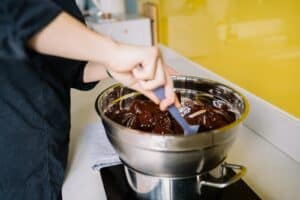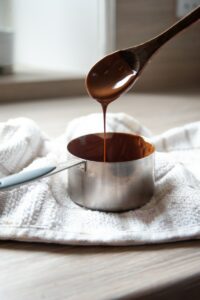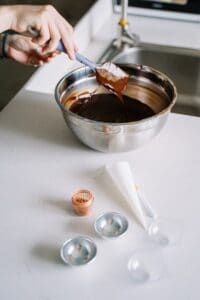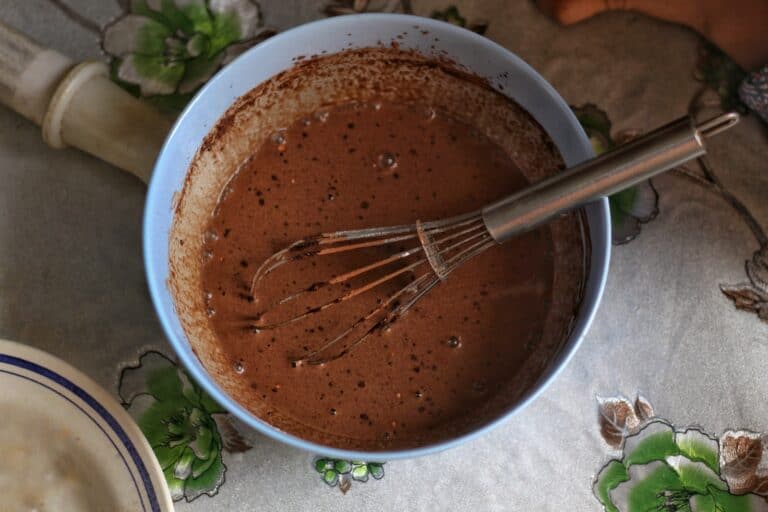Seized chocolate is a common issue many of us face while melting chocolate. It happens when 0.5–1% of the weight of the chocolate comes into contact with water, causing the cocoa butter to separate from the sugar and cocoa particles. Since the water isn’t evenly distributed, the melted chocolate becomes stiff and grainy. It’s crucial to fix seized chocolate and transform it back to its smooth texture.
When chocolate seizes, it’s generally caused by the introduction of moisture into the mix. Even a few drops of water can cling to a spatula or bowl and turn melted chocolate into a lumpy, unappealing mess. This is because cocoa particles bind together with the sugar, leaving a dry and grainy texture. If you need to melt chocolate, ensure all your utensils are completely dry and use a double boiler or a microwave at low power to avoid overheating.
Luckily, to fix seized chocolate, you can either add more liquid or fat like a small amount of hot cream, melted butter, or vegetable oil to the mixture to loosen the sugar and cocoa particles that have clumped together. Stir vigorously to encourage the cocoa butter to blend with the liquid, creating a smooth consistency. Avoid using water to dissolve the sugar, as this may result in a thicker, more grainy texture. And remember, if a whole batch of chocolate has seized, it’s best to start a new batch to achieve the best results. Now, you have a better understanding of how to prevent and fix seizing while working with everyone’s favorite treat, chocolate.
Understanding Seized Chocolate

Seized chocolate is a common issue when melting chocolate for various recipes. It occurs when the chocolate seizes, transforming from smooth, melted chocolate to a thick, grainy texture that has solid chocolate chunks. When chocolate seizes, it’s due to the presence of moisture – even a small amount of water can cause this reaction.
In chocolate, cocoa butter is the primary fat that surrounds the sugar and cocoa particles. When water is introduced to the mixture during melting, it causes these dry particles – sugar and cocoa – to stick together, resulting in the seizing of the chocolate. High temperatures are another instigator, so keep an eye on the heat to avoid seizing.
The primary way to fix seized chocolate is to add more liquid, which helps to separate the cocoa particles. Adding a small amount of hot cream, boiling water, syrup, or liqueur can help restore the smooth texture. This is only a temporary fix, though – it’s crucial to prevent seizing by ensuring that the bowl and other utensils used for melting are completely dry.
Melt chocolate using either a double boiler or a microwave (at low power). If using a double boiler, use low heat and ensure the water doesn’t touch the bottom of the bowl holding the chocolate. Stir constantly to achieve a smooth and even melt. When melting in a microwave, use short intervals and stir often to avoid burning the chocolate.
To fix seized chocolate, follow these steps:
- Remove the chocolate from heat immediately to prevent further damage.
- Add a small amount of vegetable oil, melted butter, or any other fat to the mixture and stir vigorously until the chocolate returns to a smooth consistency.
- If the above step doesn’t yield the desired result, try adding a tiny amount of boiling water or hot cream, stirring until completely incorporated.
Remember, though, that sometimes it’s not possible to recover a severely seized chocolate. If the chocolate remains thick and grainy after adding fat and liquid, it’s likely best to start with a new batch of chocolate.
While the seized chocolate might not be ideal for dipping recipes or cakes, it can still be used in other recipes like brownies or sauces, where the graininess would be less noticeable.
In summary, the keys to understanding seized chocolate are to be aware of the factors that cause chocolate seizing, such as moisture and high temperatures, and to know how to correct it – by adding more liquid or fat into the mixture – if necessary.
Common Causes and Prevention
Seized chocolate can be quite a nuisance when you’re trying to create delicious desserts. The main cause of chocolate seizing is the introduction of moisture to the cocoa particles when melting. Tiny amounts of water can bind the sugar and cocoa in a solid mass, leaving behind a grainy texture. In this section, I’ll discuss the common causes and some prevention tips to help you achieve smooth, melted chocolate every time.

Common Causes
- Water: The primary cause of chocolate seizing is the presence of moisture. Even the tiniest amount of water can trigger this issue. So always ensure that your bowls, utensils and other tools used for melting chocolate are completely dry.
- High Temperatures: Attempting to melt chocolate at too high a temperature can also lead to seizing. Chocolate requires a gentle heat source and constant stirring to melt smoothly.
Prevention Tips
- Double Boiler: Using a double boiler provides a gentle, indirect heat source for melting chocolate. If you don’t have a double boiler, you can create one by placing a heatproof bowl over a saucepan of simmering water. Ensure that the bottom of the bowl is not touching the water.
- Stir Constantly: As you melt the chocolate, be sure to stir continuously. This helps to distribute the heat evenly, preventing the chocolate from overheating and seizing.
- Add Fat: By adding a small amount of vegetable oil or another fat to the chocolate, you can help reduce the likelihood of the chocolate seizing. This can be especially helpful when dipping items into the melted chocolate, which may introduce moisture.
- Select Quality Chocolate: Chocolate with a higher percentage of cocoa solids and fat (cocoa butter) tend to melt more smoothly compared to those with lower percentages.
Despite all these precautions, if your chocolate seizes, there are a few ways to fix seized chocolate:
- Add More Liquid: Adding extra milk, cream, or another liquid in small amounts (1 tablespoon at a time) and stirring vigorously often helps to break down the solid chocolate chunks and create a smooth texture.
- Create a New Batch: Mix the seized chocolate into a new, larger batch of properly melted chocolate. This can help distribute the sugar and cocoa particles more evenly, reducing the graininess.
- Use in Baking: Seized chocolate can still be repurposed for baking recipes that require sugar and cocoa, such as cakes, brownies, or cookies.
To summarize, always be mindful of moisture and heat when working with chocolate. Use a double boiler, stir constantly, and consider adding a bit of fat to promote smooth melting. With these tips, you can prevent chocolate from seizing and create delicious chocolate treats.
Fixing Seized Chocolate: Methods
While working with melted chocolate, it’s not uncommon to experience the frustration of seized chocolate. This occurs when cocoa butter separates from sugar and cocoa particles, taking your dreamy melted goodness and leaving you with a grainy, solid mess. But don’t fret; there are ways to fix seized chocolate and save your culinary creation.
Adding Liquid

The primary cause of chocolate seizing is usually moisture, as water acts as a binding agent for sugar and cocoa particles. When added in a small amount, this causes the melted chocolate to seize up into a thick, grainy texture. To fix this, you can try adding more liquid to the mixture:
- Hot cream: Gradually add hot cream to the seized chocolate, stirring constantly. Make sure to add the cream in small increments to create a smooth transition.
- Boiling water: In a double boiler, add a small amount of boiling water to the seized chocolate, and stir vigorously until the mixture becomes smooth.
- Other liquids: Depending on your recipe, other liquids like milk, syrup, or liqueur could be suitable options for fixing the seized chocolate.
Remember to consistently stir the mixture as you add more liquid to maintain a smooth texture and prevent sugar and cocoa particles from sticking to one another.
Adding Fat
Another way to fix seized chocolate is by adding fat. The addition of fat, such as melted butter or vegetable oil, envelops the dry particles in seized chocolate, thus helping to create a smooth mixture. Again, make sure to add the fat in small increments and stir constantly while adding.
Starting Fresh
Sometimes the best course of action is to start with a new batch of chocolate. If you’ve tried the above methods and the chocolate is still not cooperating, it might be time to face the facts and begin anew. Remember, when melting chocolate, use low heat, a completely dry bowl, and avoid introducing any moisture to prevent seizing.
To sum up, fixing seized chocolate involves either adding more liquid or fat to the mixture, depending on the recipe and your preferred method. These techniques can turn grainy, solid chocolate chunks back into a velvety smooth creation perfect for dipping, baking, and topping. So don’t give up on that batch of seized chocolate – with these methods, you can recover your culinary creation and enjoy a delicious, chocolate-infused treat!
Final Thoughts: Avoiding Seizing in the Future
Seized chocolate can easily ruin a dessert and throw a wrench in one’s baking plans. To make sure the same issues don’t crop up again, there are a number of precautionary measures that can be taken.
When working with melted chocolate, it’s crucial to control the temperature and the presence of any moisture in the mix. Try using a double boiler or a water bath instead of direct heat, and stir constantly. This way, the chocolate won’t be exposed to high temperatures, resulting in a smoother melting experience.
While melting chocolate, it’s essential to keep moisture at bay. Any contact with water can cause the sugar and cocoa particles to clump together, giving the mixture a grainy texture. One tip for preventing seizing is to ensure that the bowl, utensils and the surface area are completely dry.
If seized chocolate does occur, there are a few ways to fix it:
- Add a small amount of fat, like vegetable oil or melted butter, to thin out the chocolate. Stir vigorously until the desired smooth texture is achieved.
- In some cases, adding more liquid, like hot cream or liqueur, can also help fix seized chocolate by allowing sugar and cocoa particles to dissolve once more.
- If a sauce recipe calls for melted chocolate, start over with a new batch and gently mix in the other ingredients after the chocolate has melted to prevent seizing.
- Solid chocolate chunks are less likely to seize than cocoa powder when introduced to liquids, so opt for solid chocolate whenever possible.
Here’s a quick recap on how to avoid seizing in the future:
- Use a double boiler or water bath
- Stir chocolate constantly
- Keep all utensils and surfaces completely dry
- Use solid chocolate in recipes when possible
By following these guidelines and careful attention to process, it’s relatively simple to prevent seized chocolate from happening. This knowledge will open up endless possibilities for deliciously smooth and silky chocolate treats, from brownies and cakes to dipping sauces and more!
Other suggested articles:
